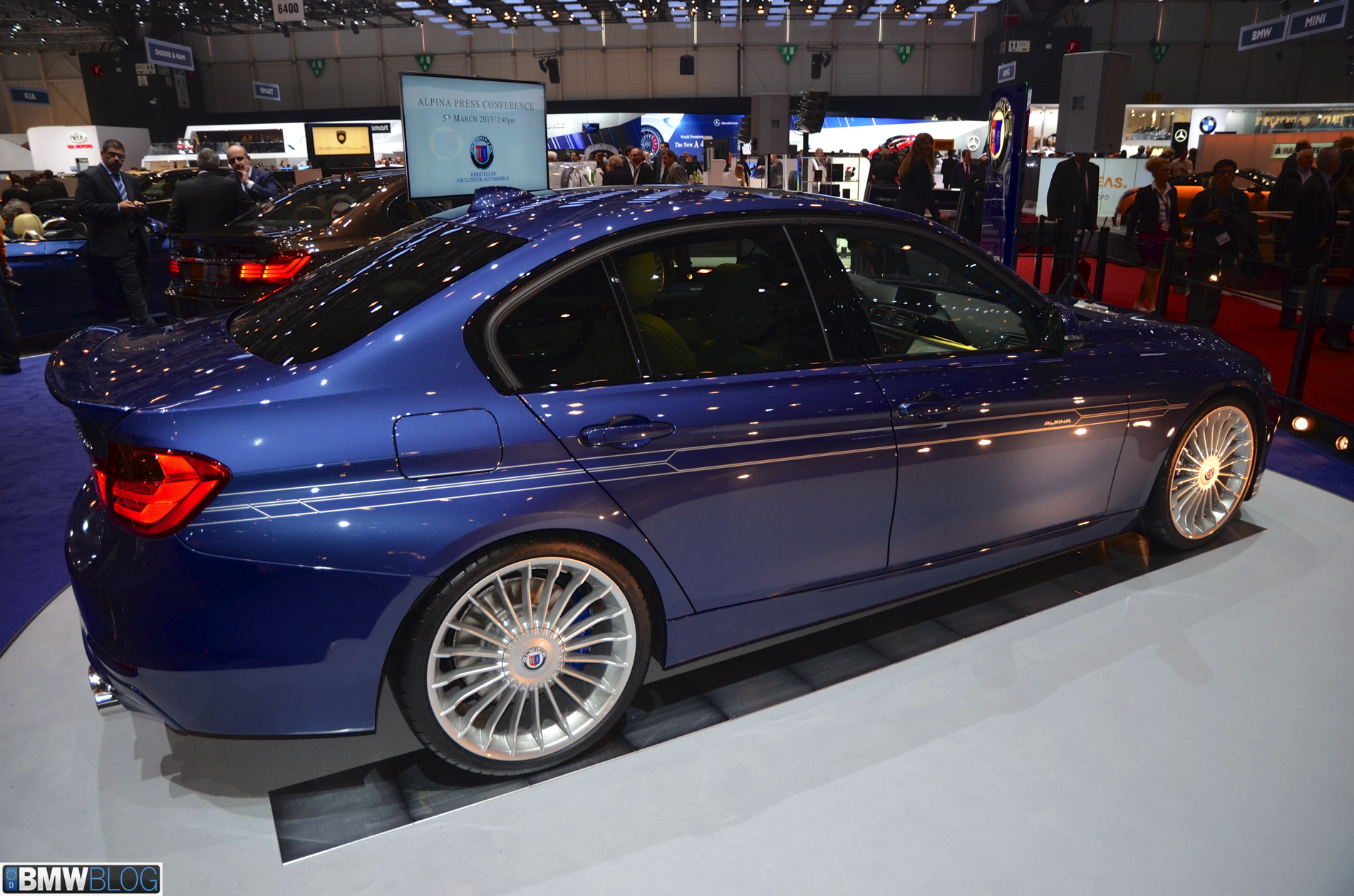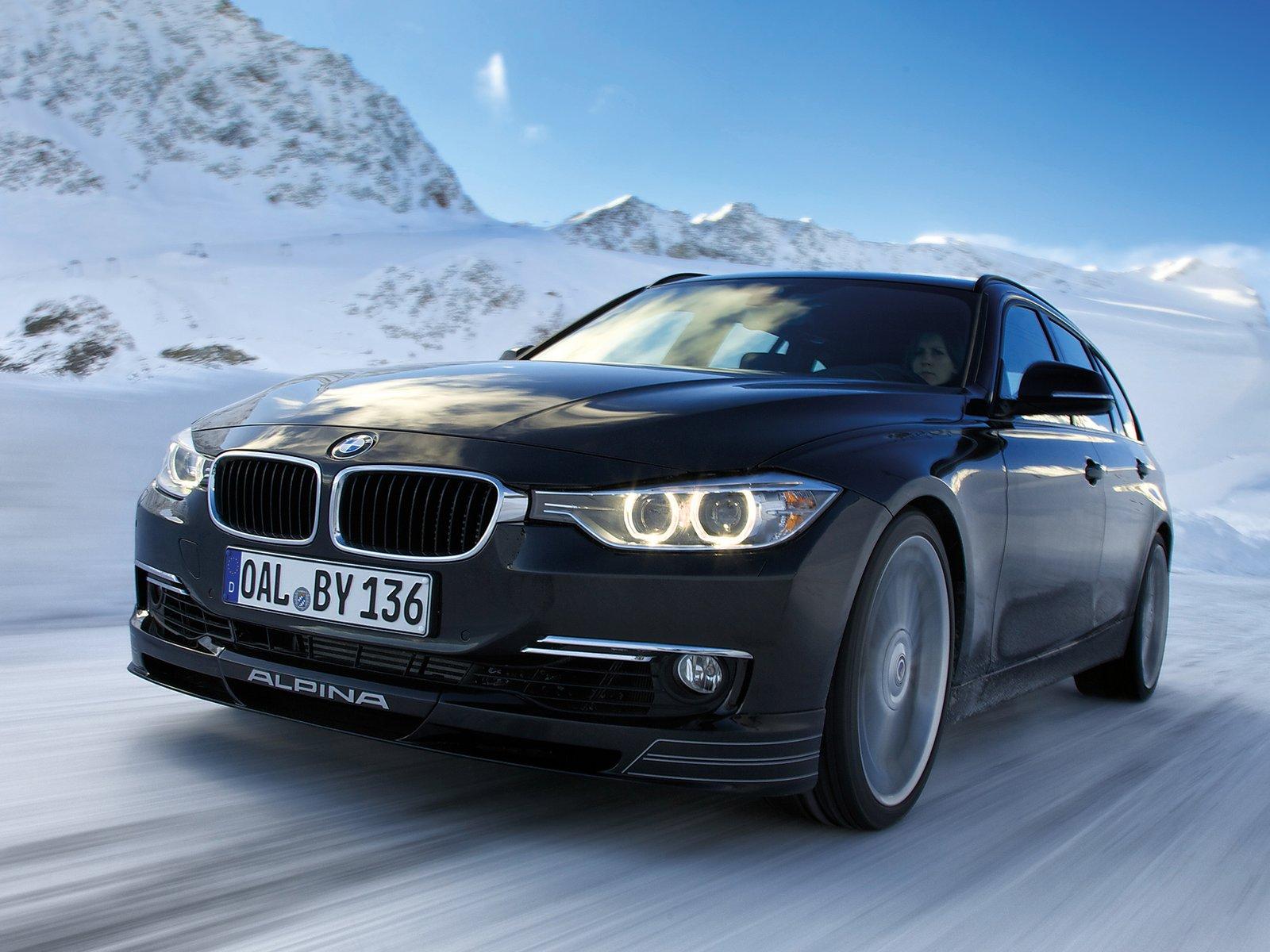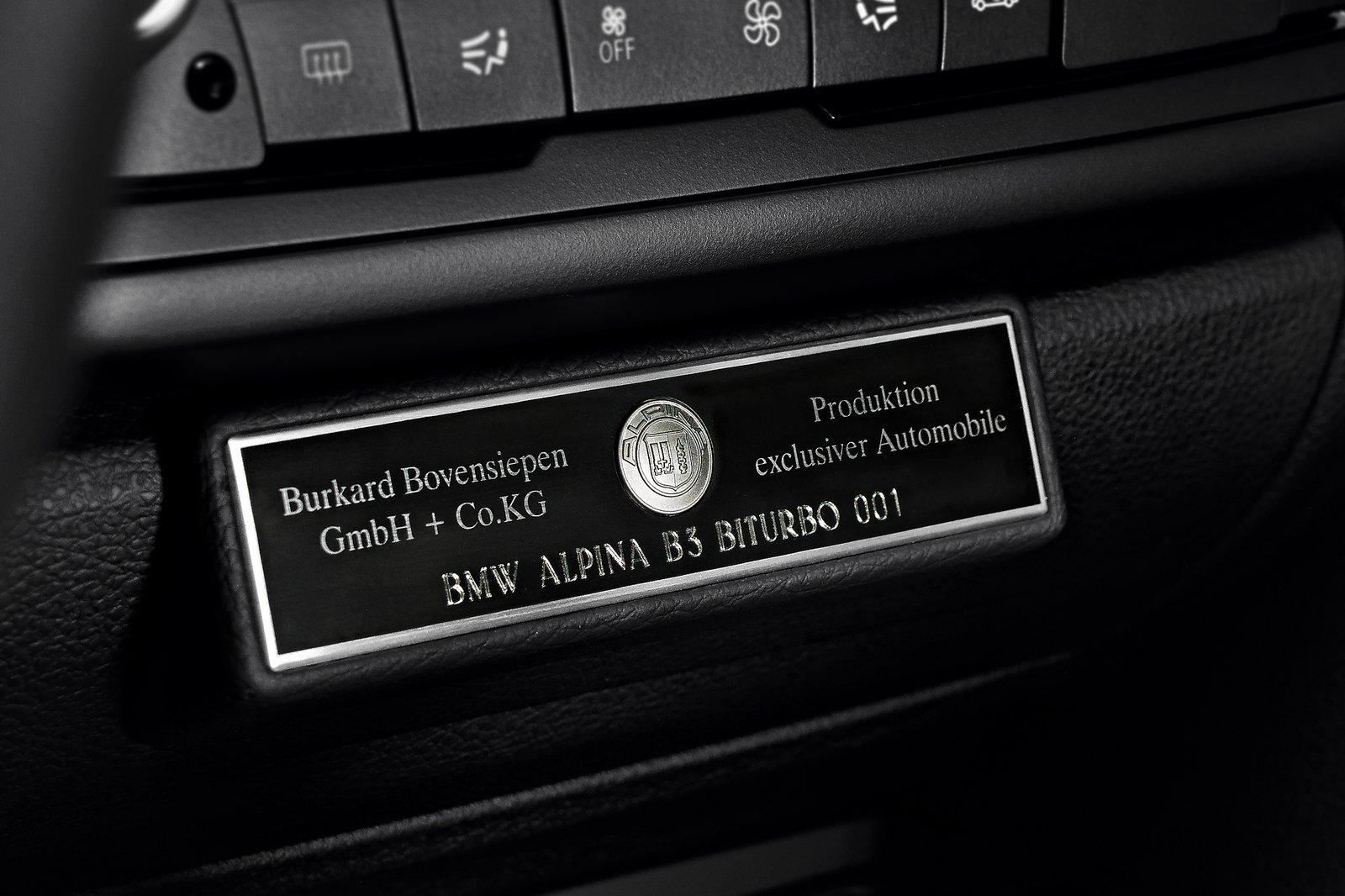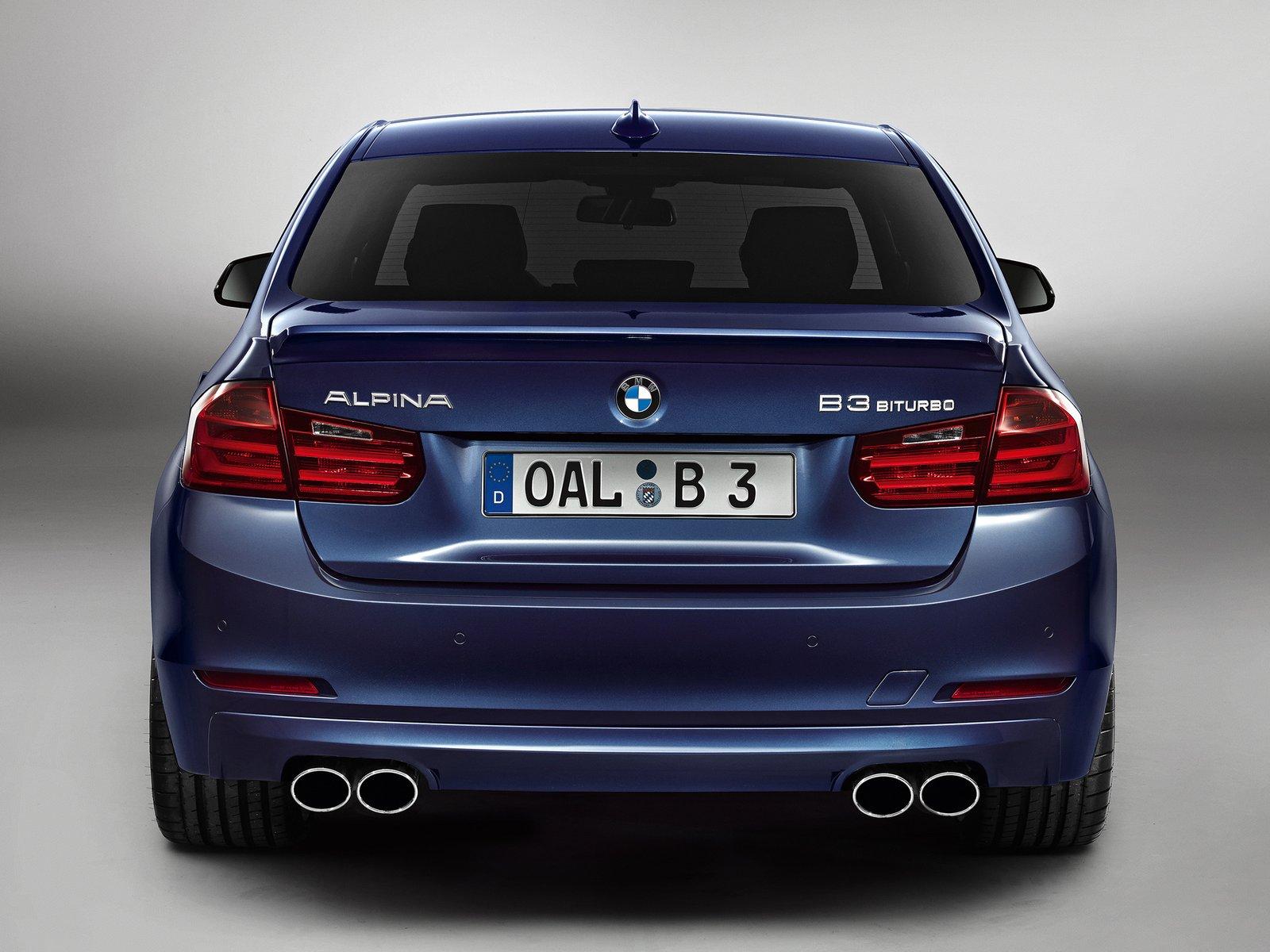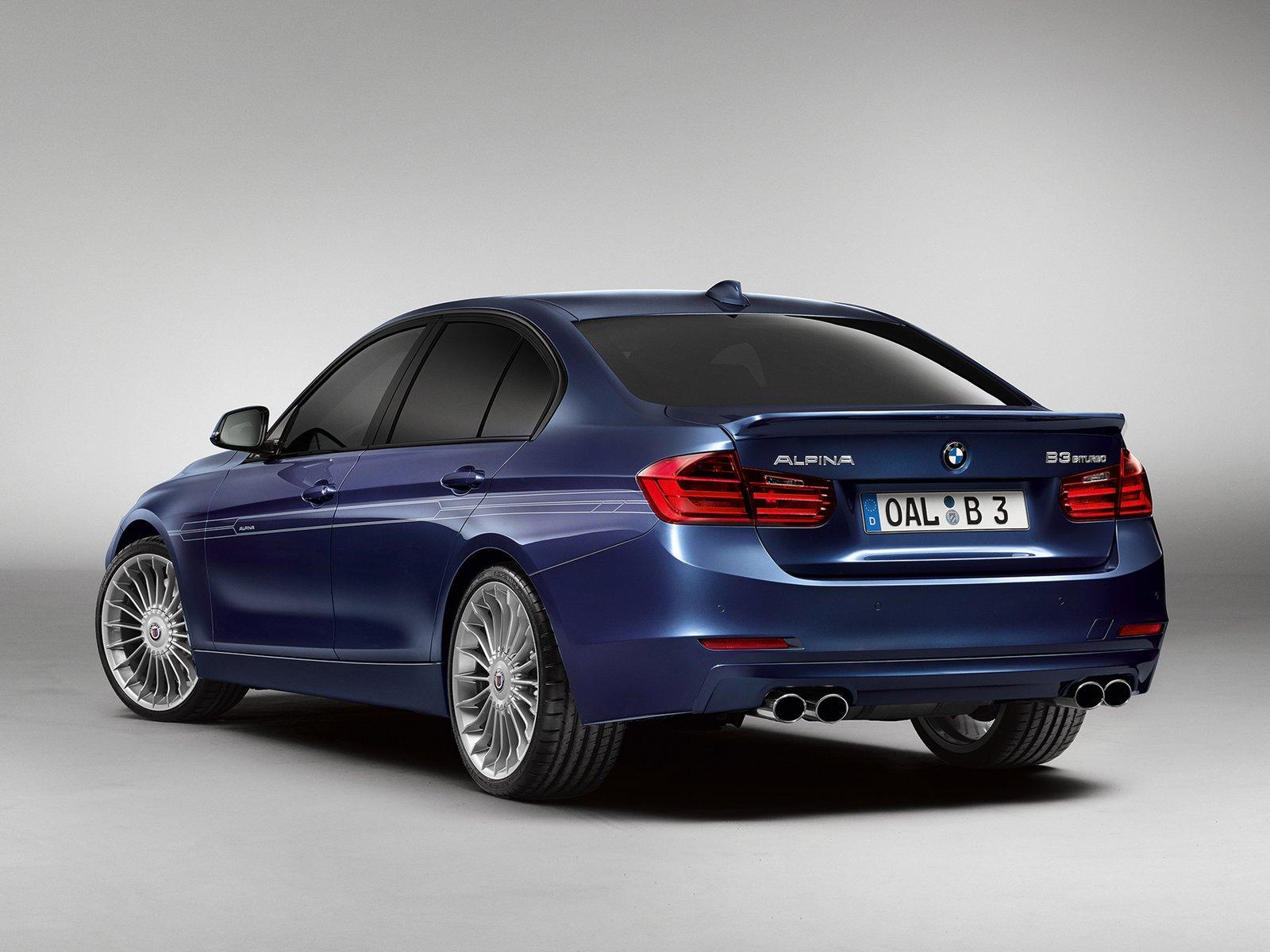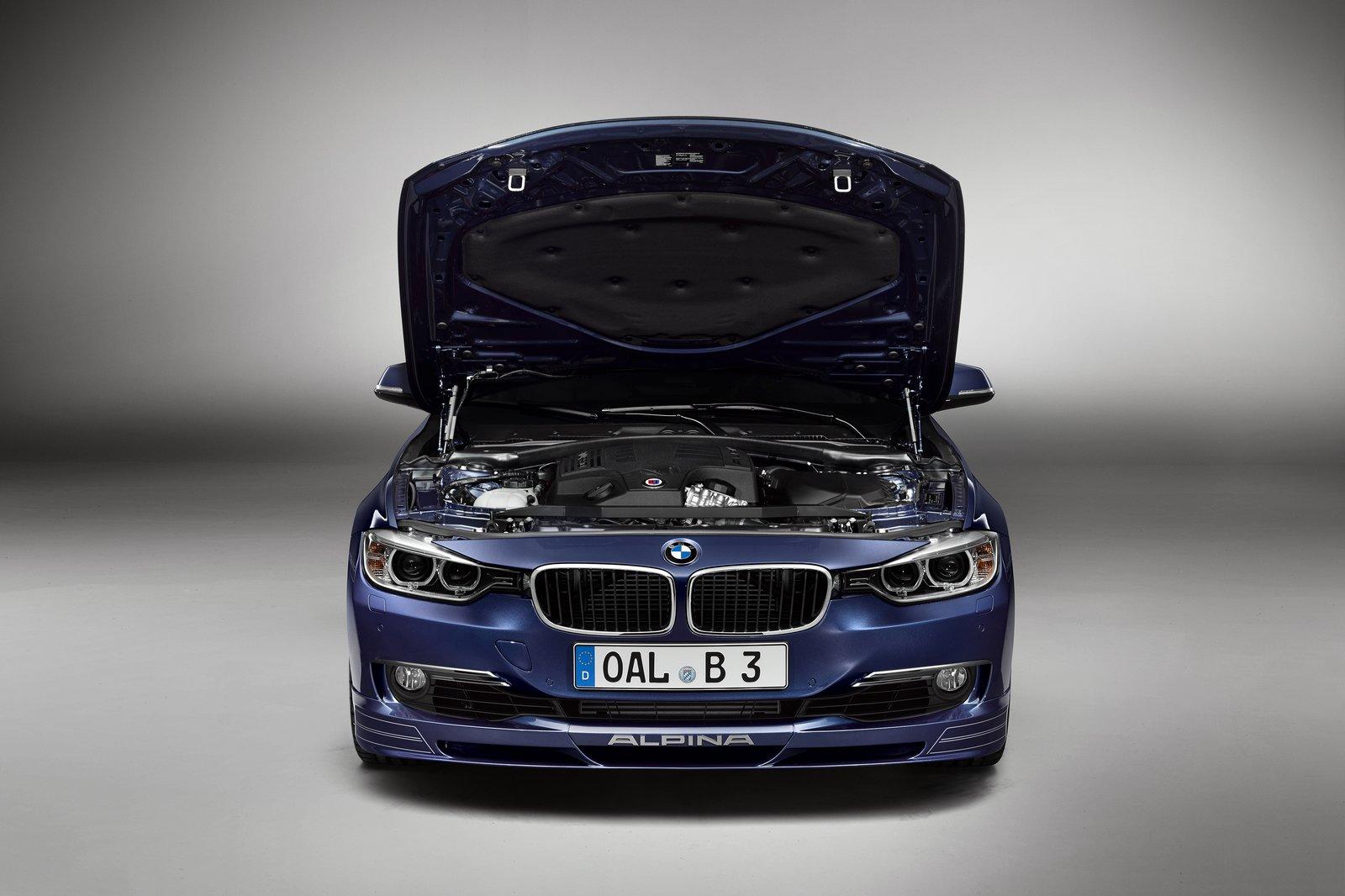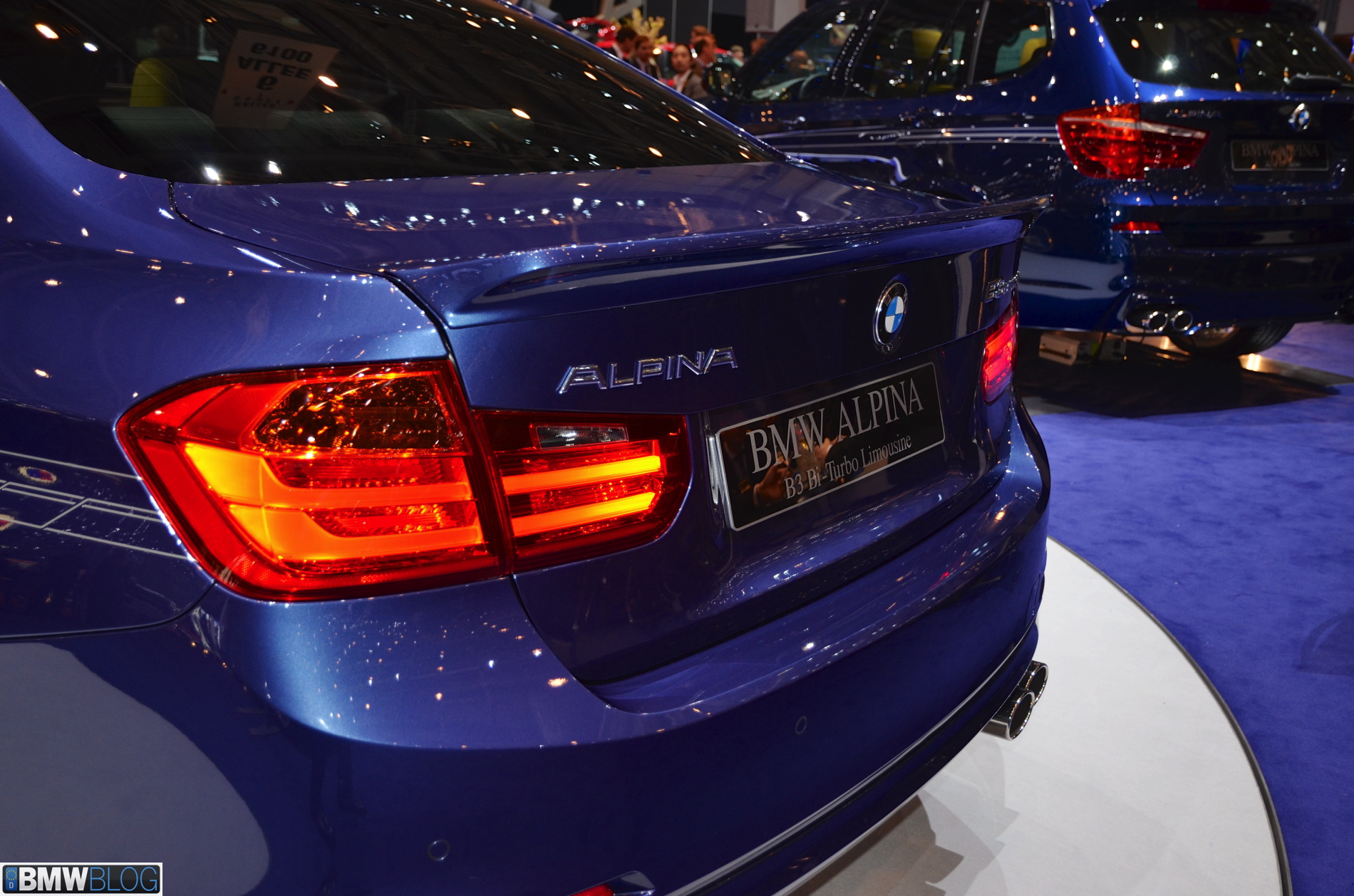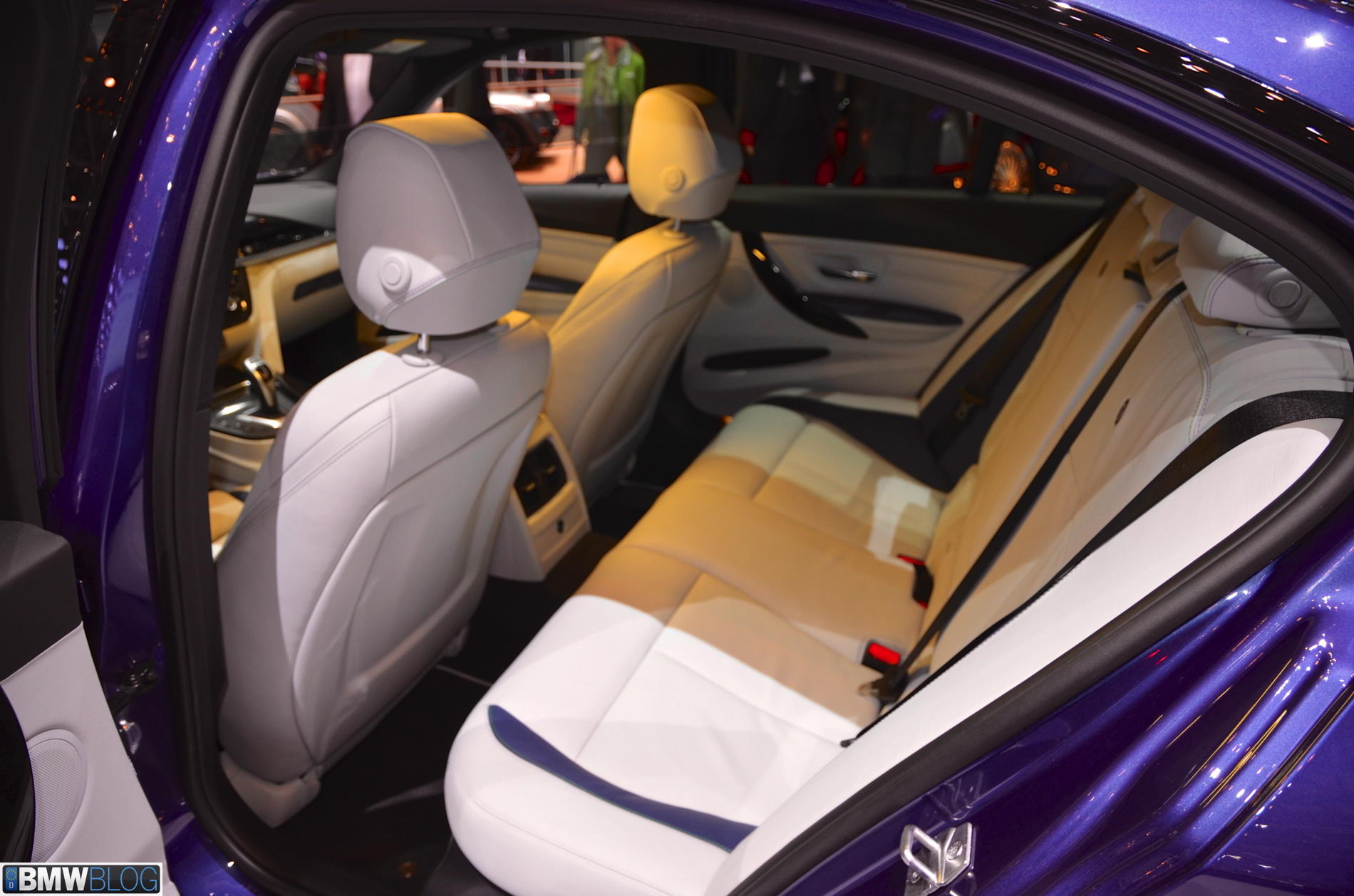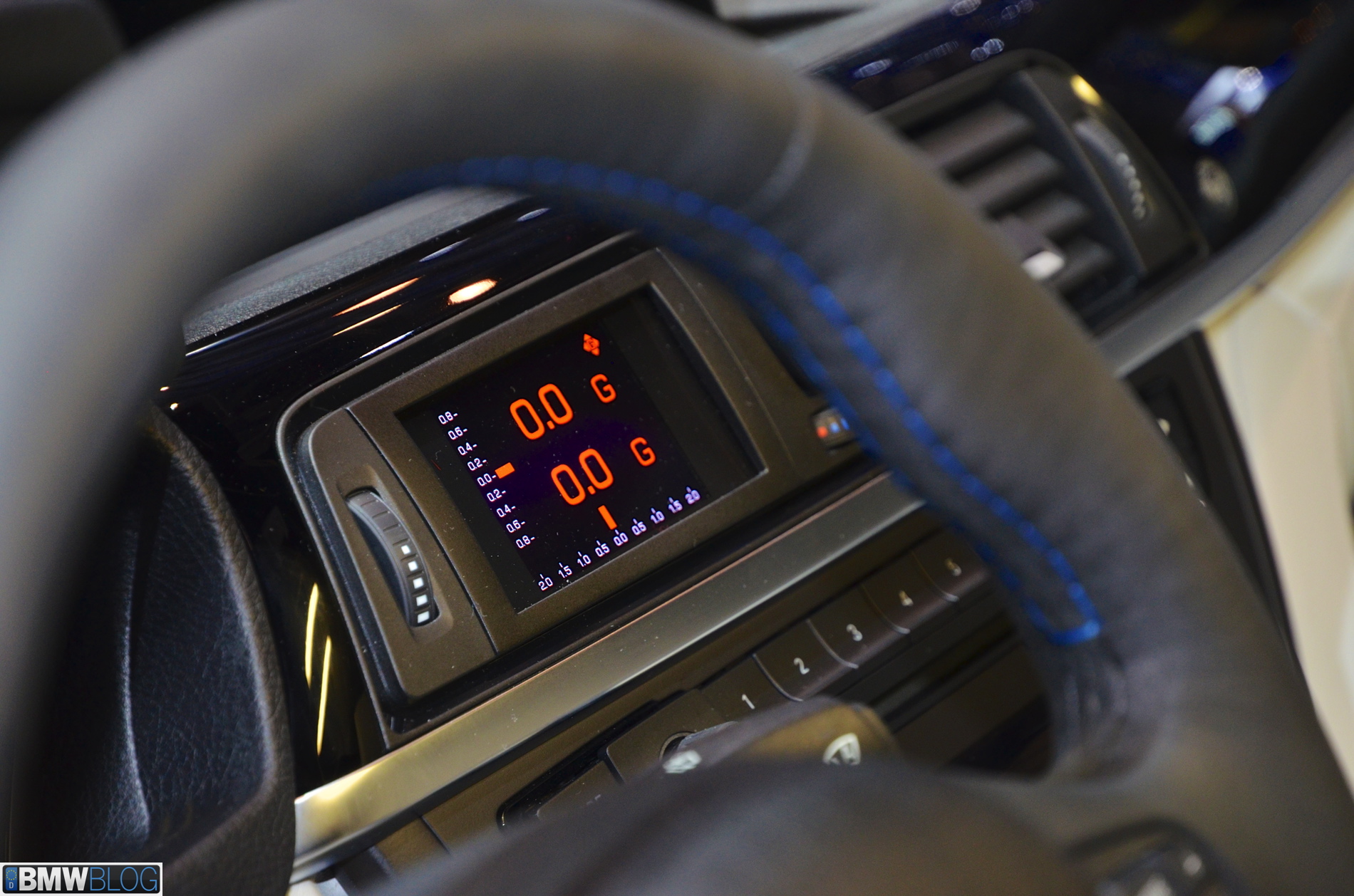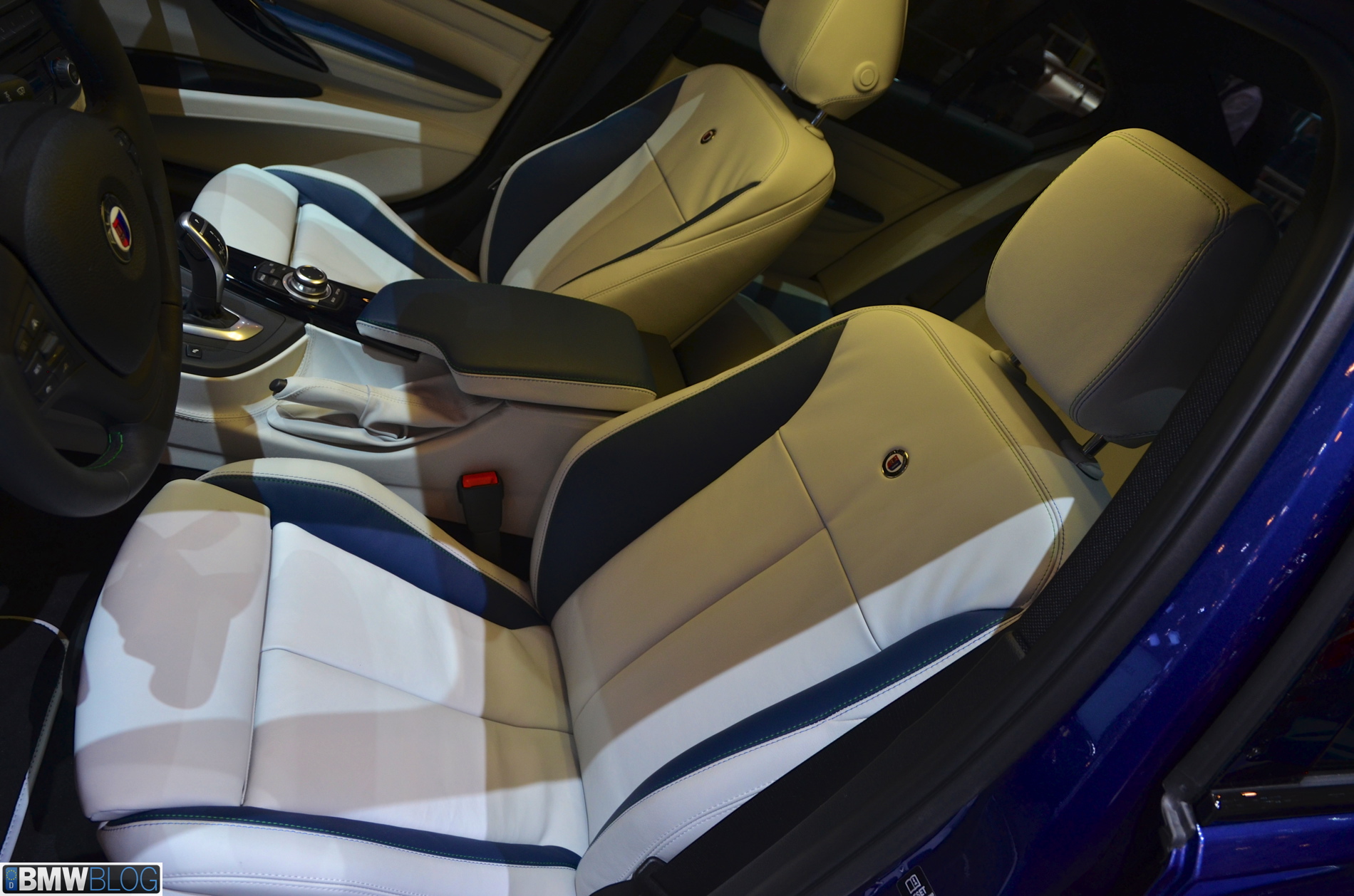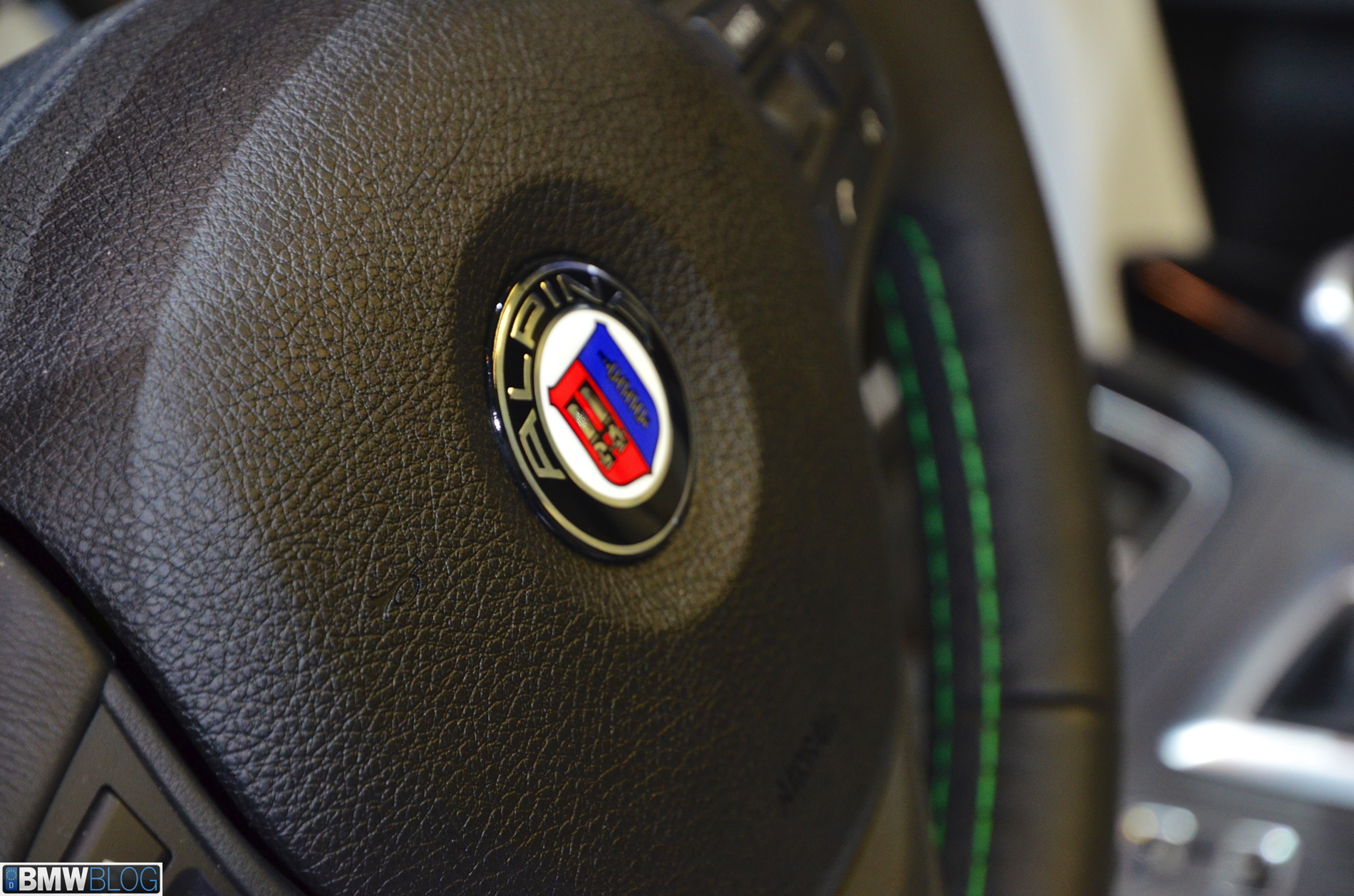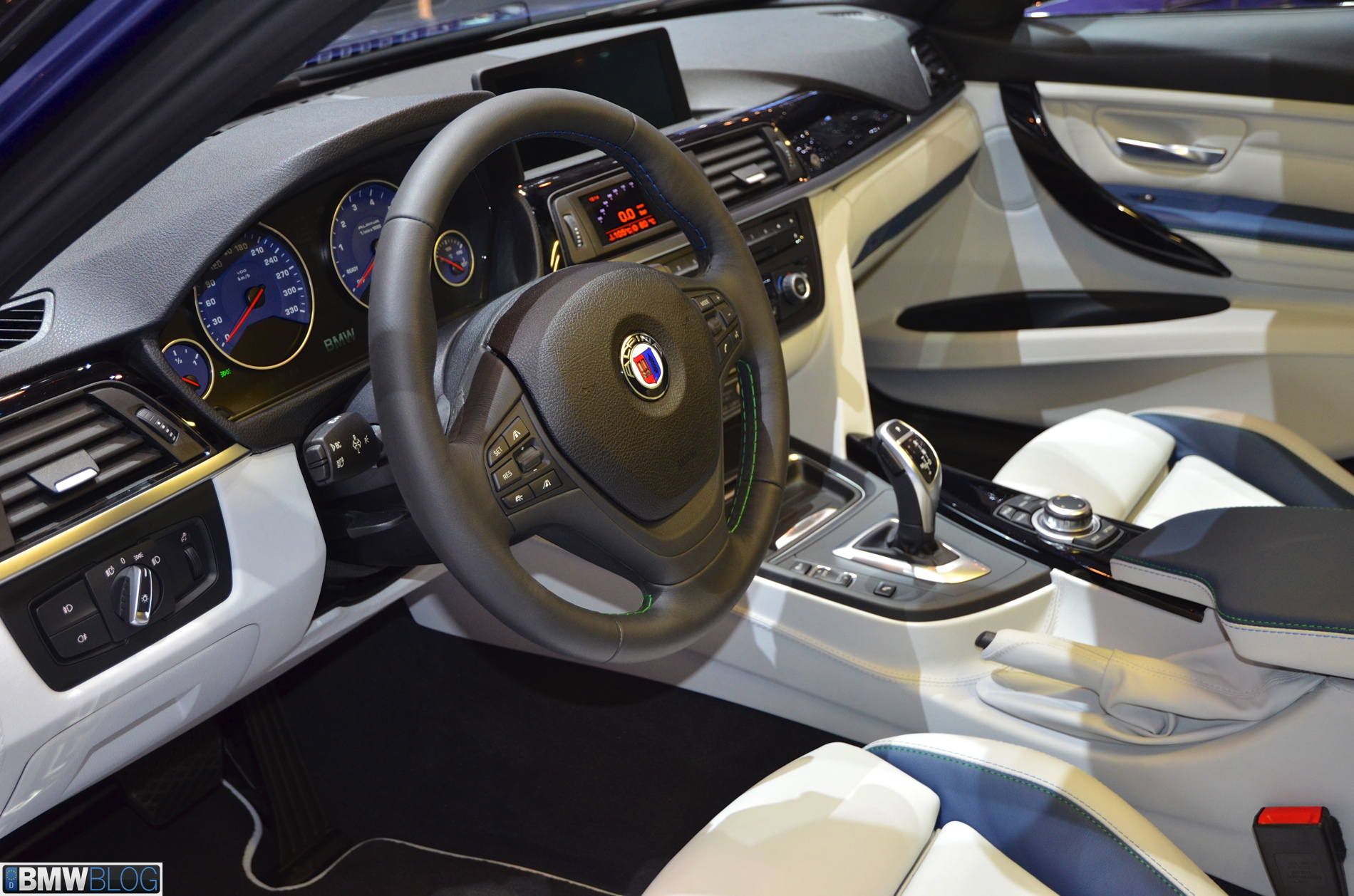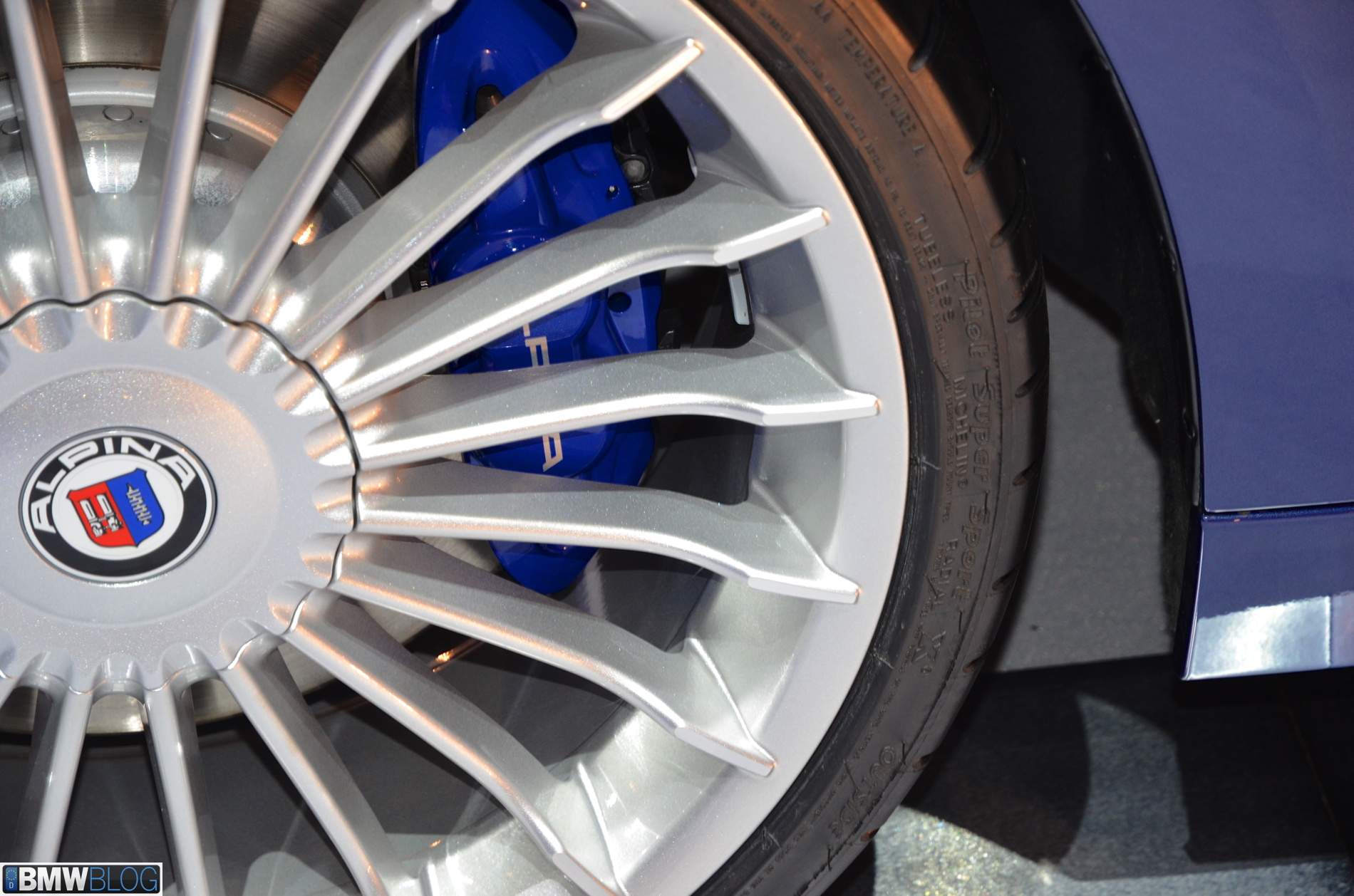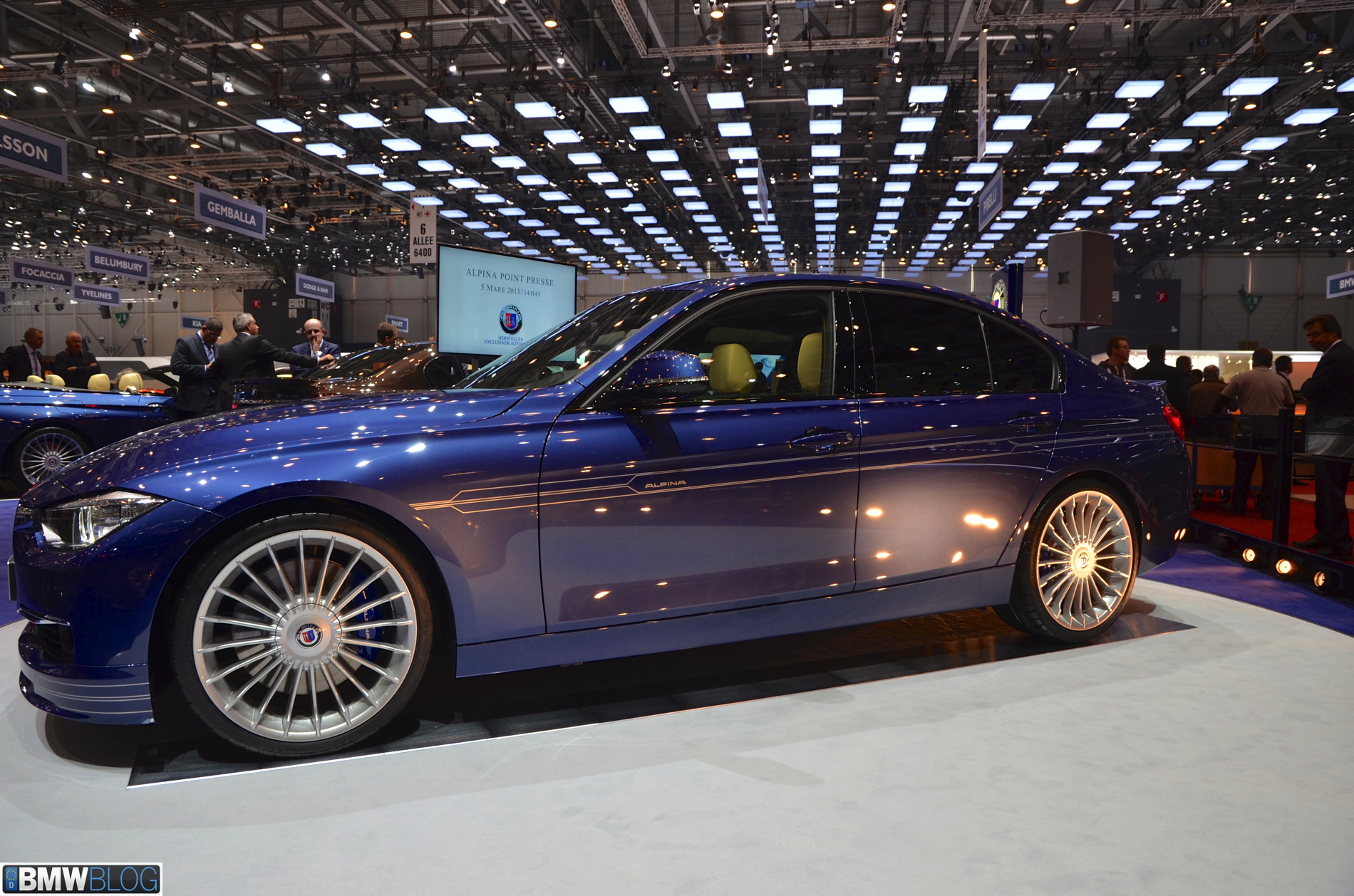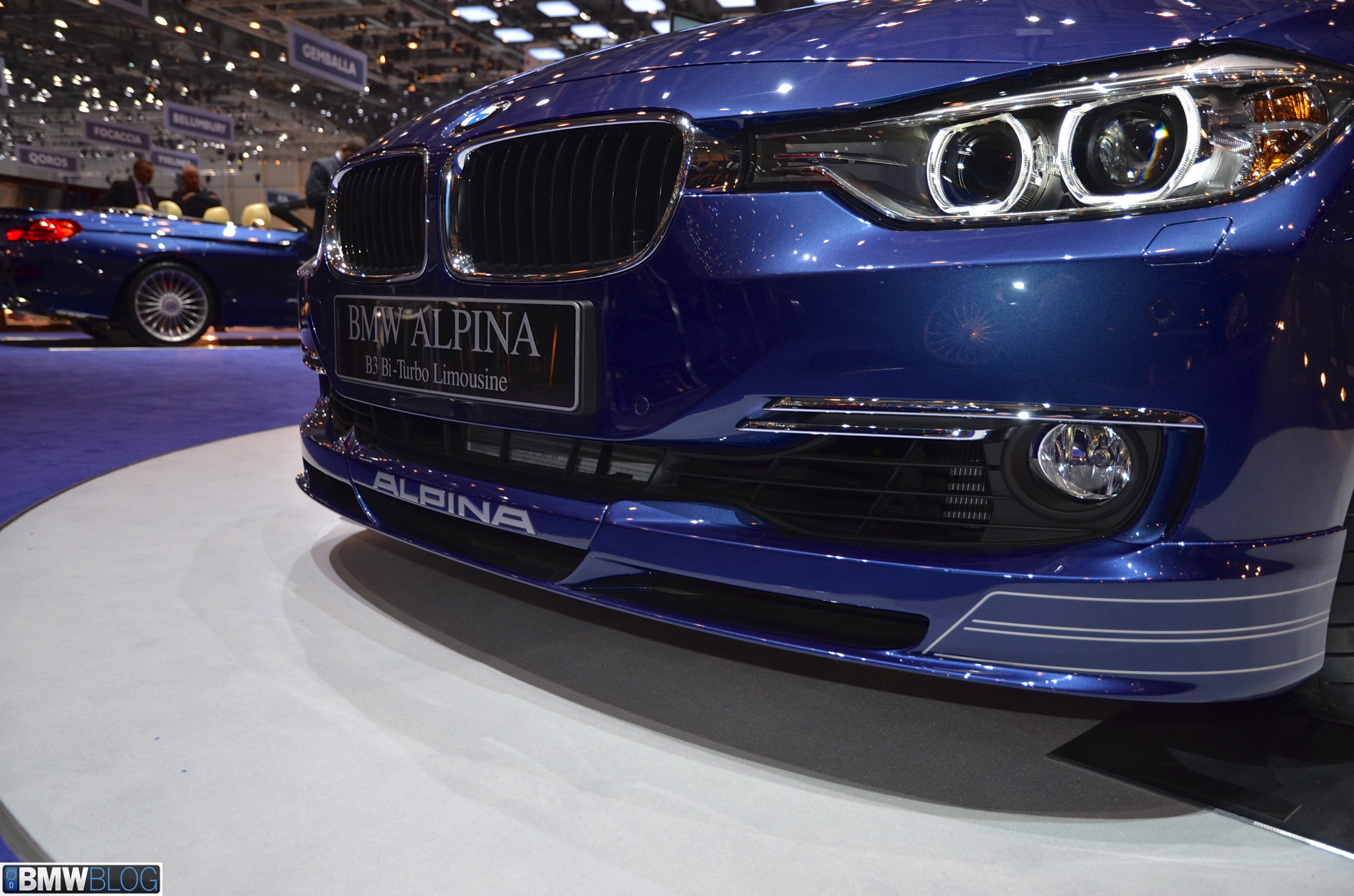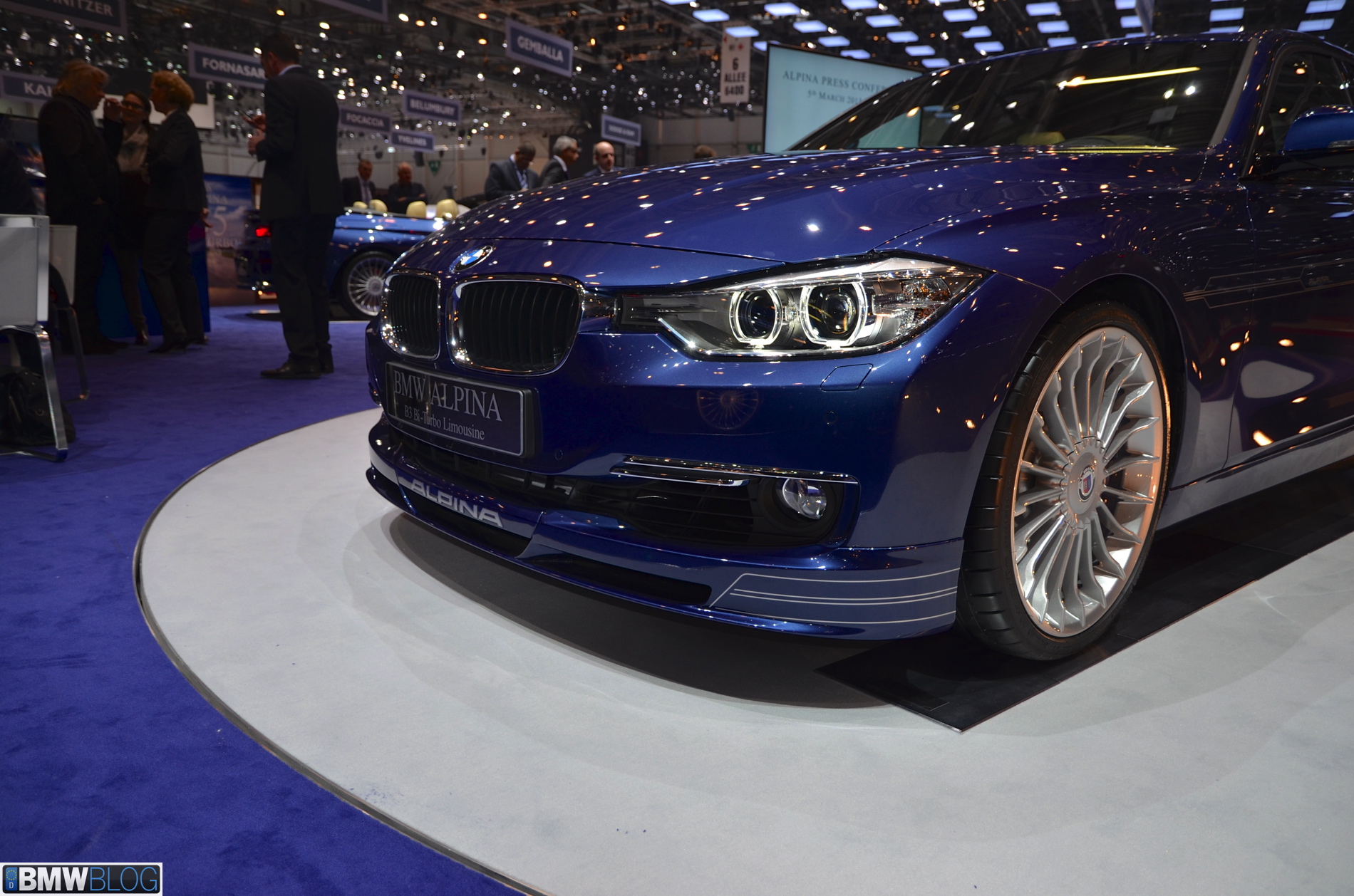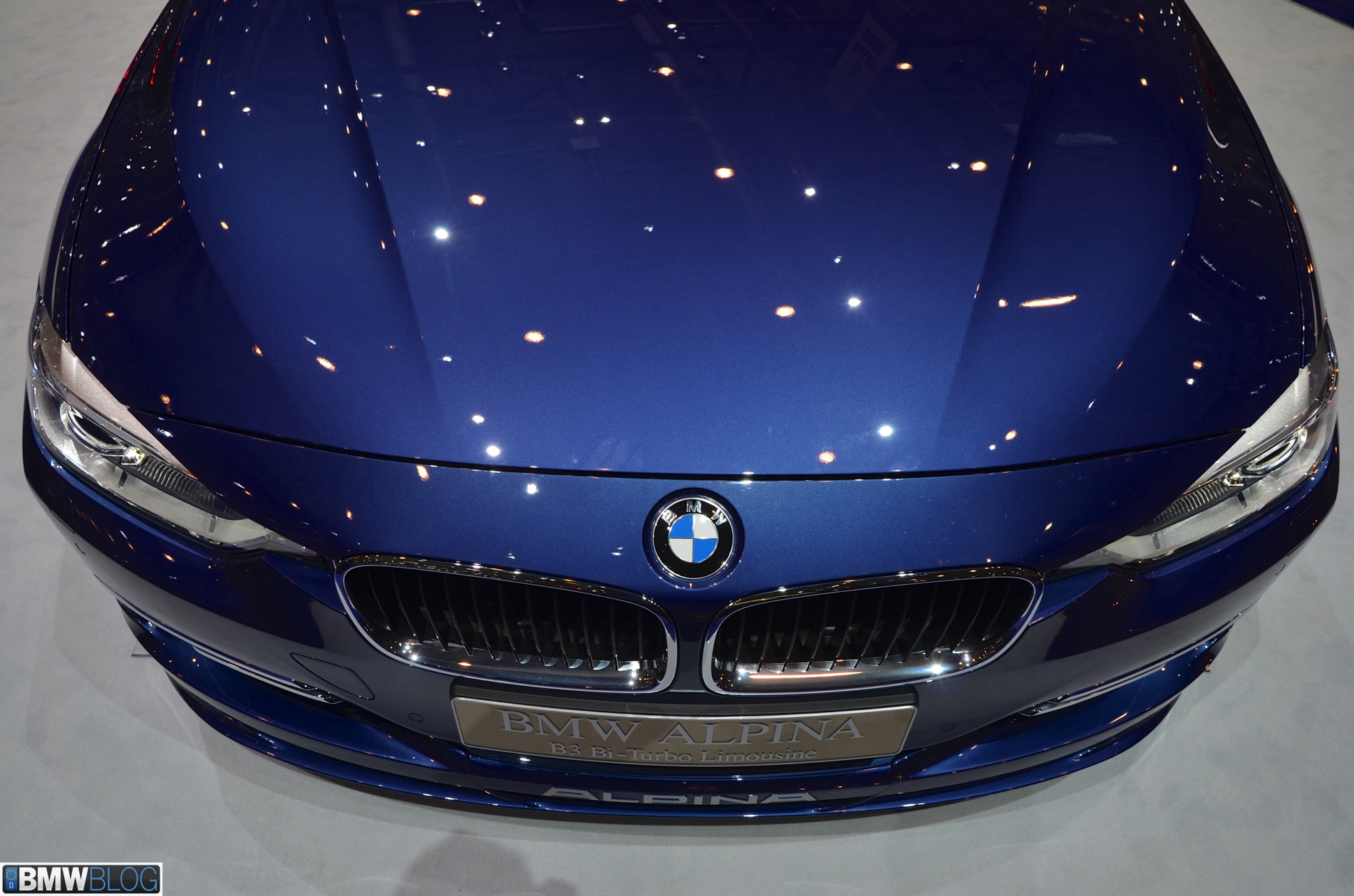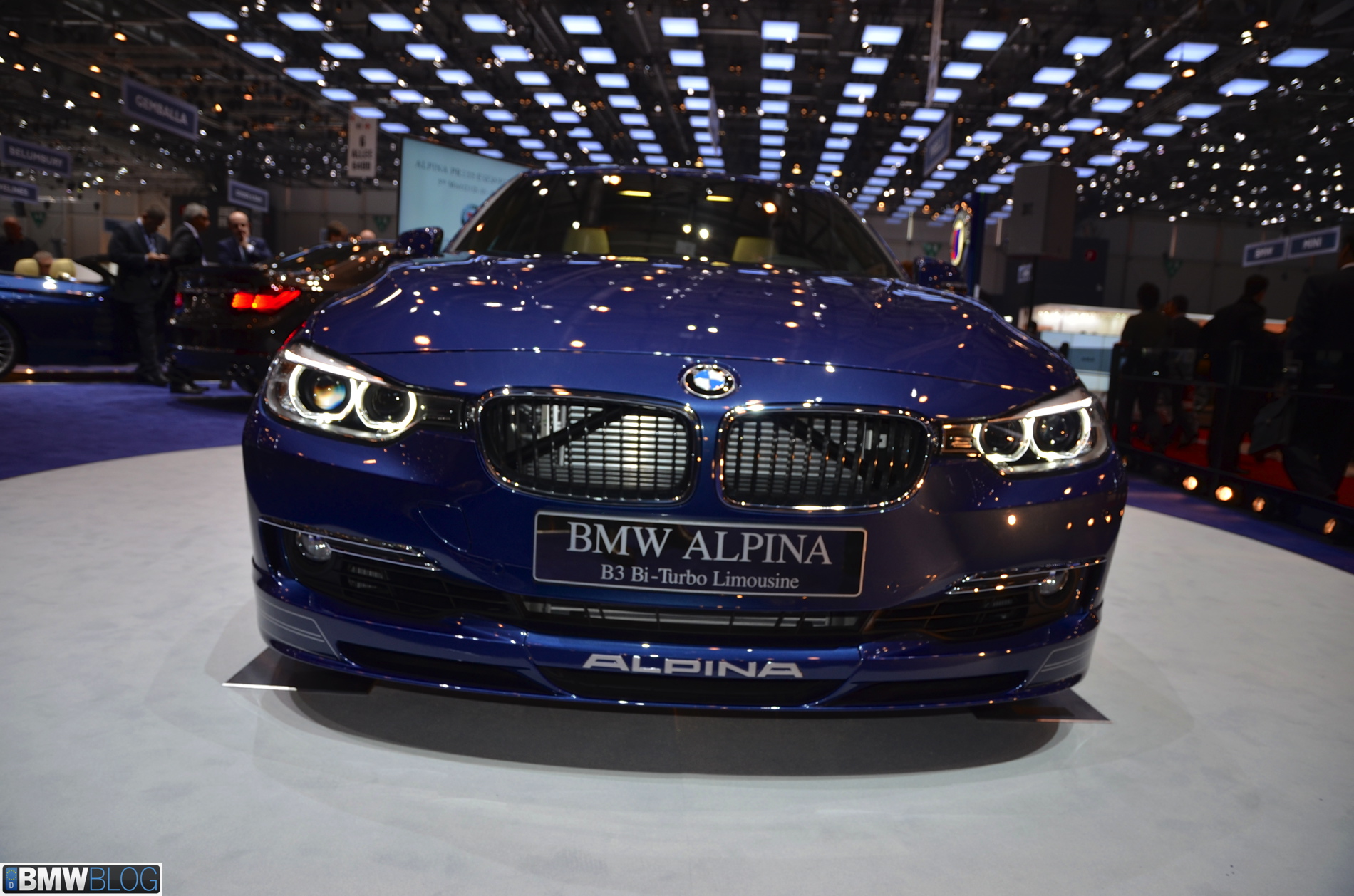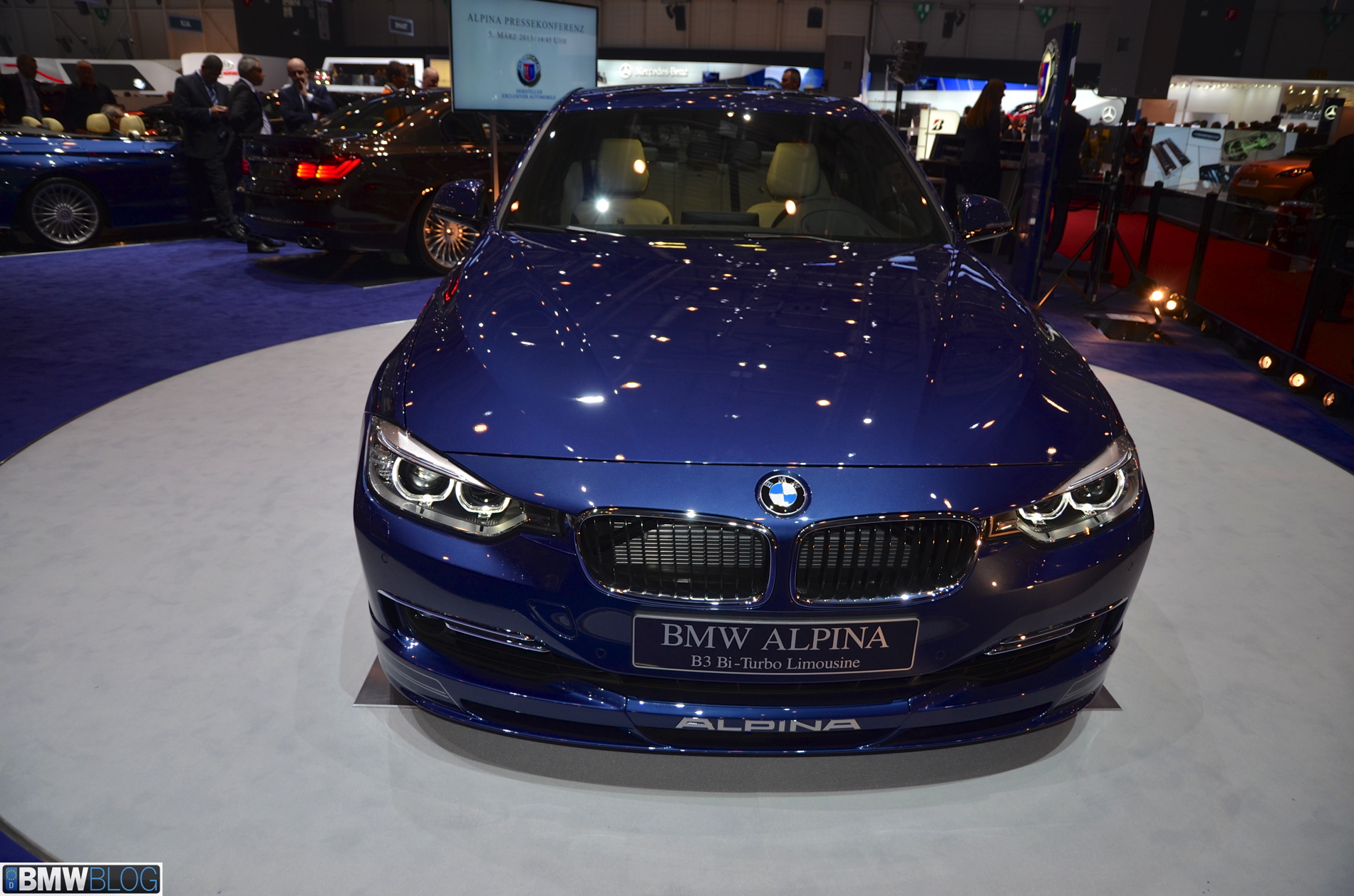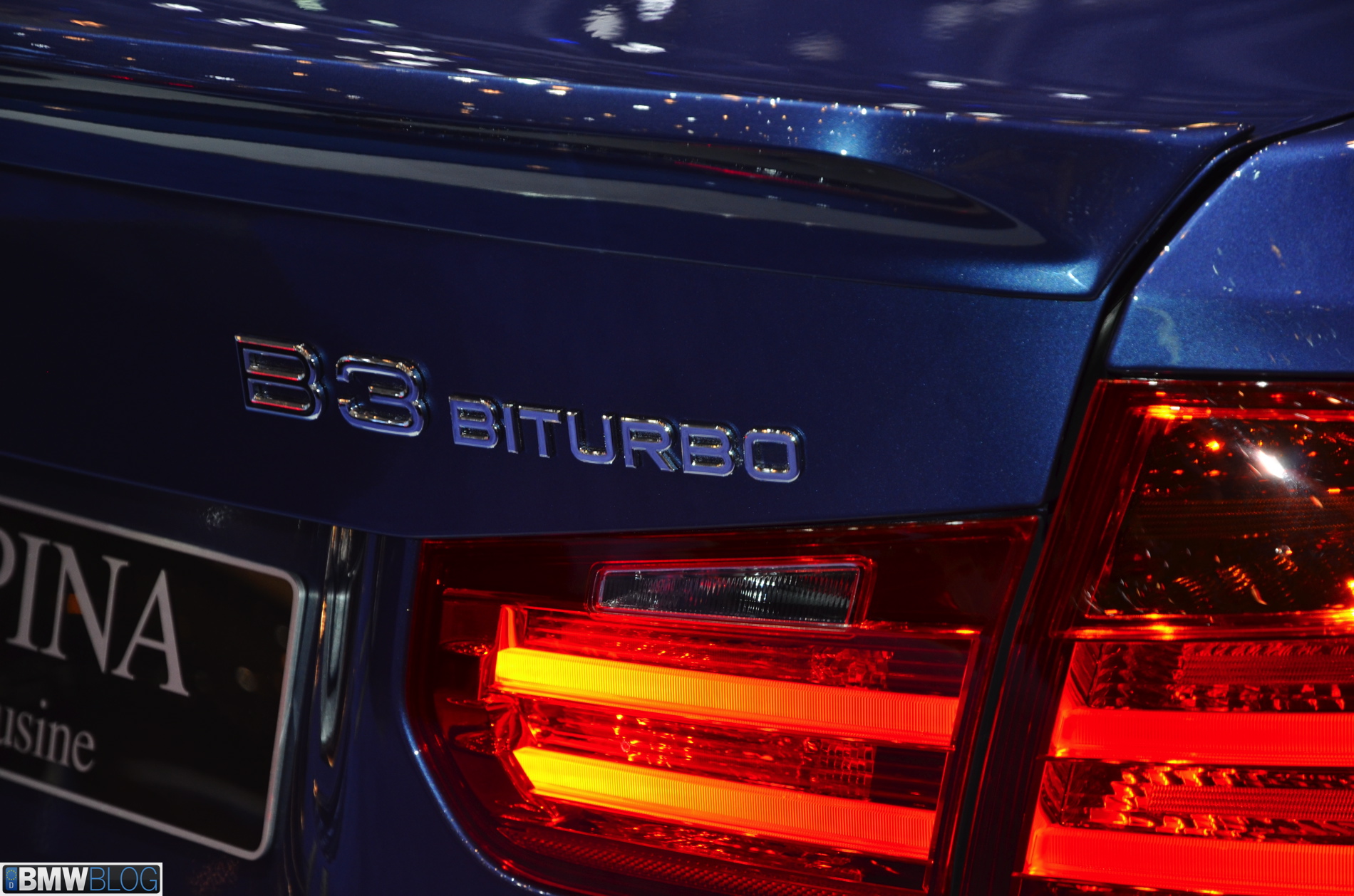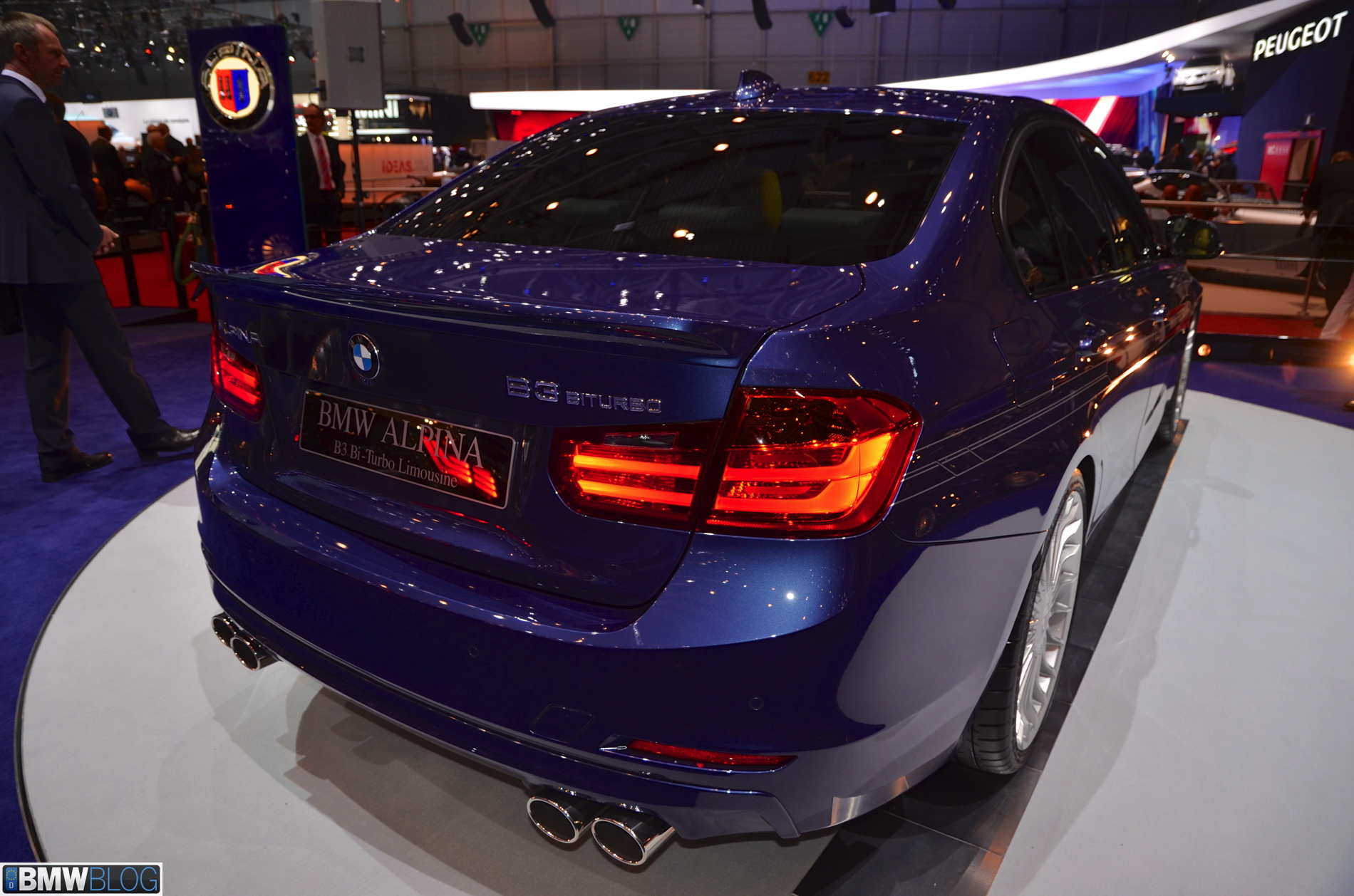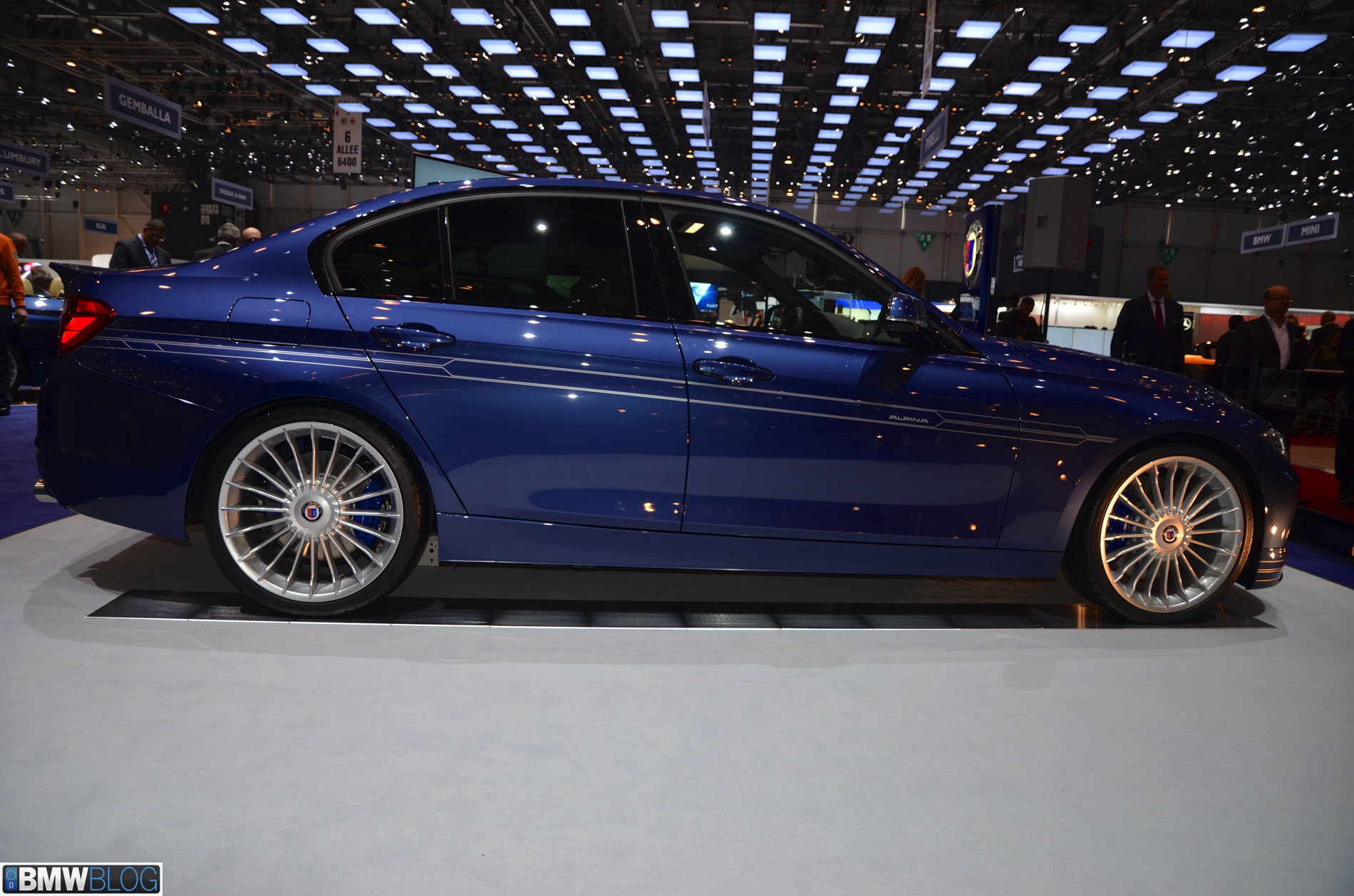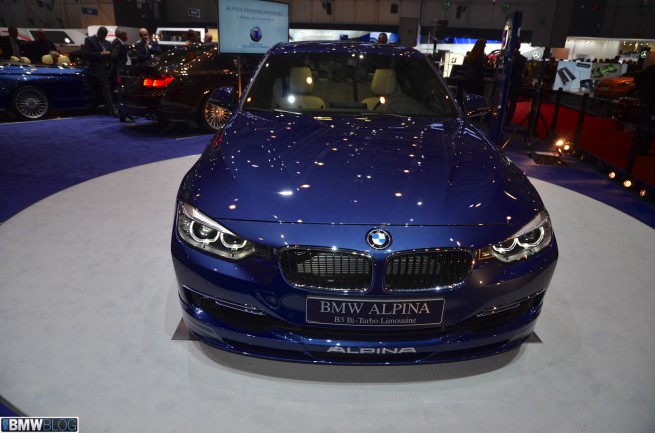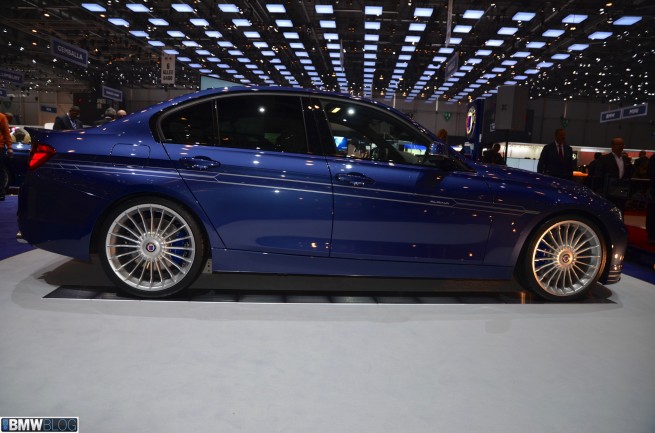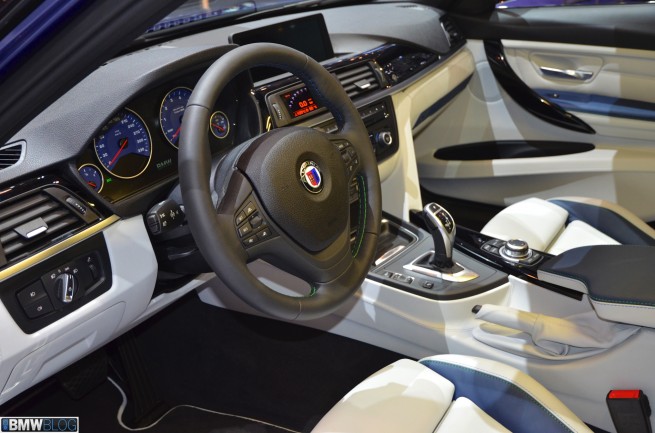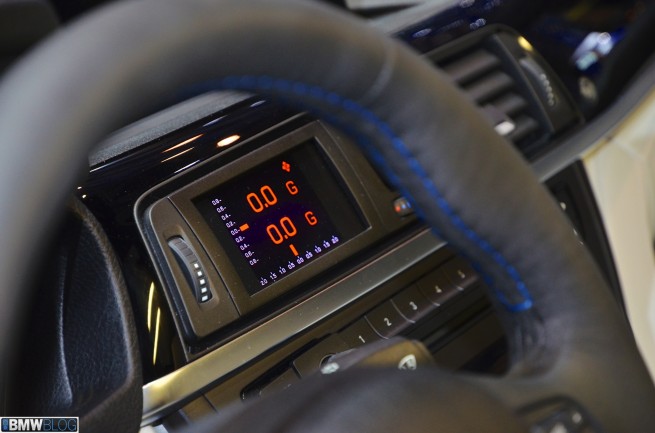ALPINA has released today in Geneva the new B3 Biturbo in both sedan and touring variants.
Under the hood, the B3 Biturbo models share the same 3.0-liter, twin-turbo, straight-six engine producing 410 horsepower (310 kW) between 5,500 rpm and 6,250 rpm, and 598 Nm of torque (442 lb-ft) at 3000 rpm. The transmisison of choice is a ZF eight-speed automatic.
The B3 Biturbo runs from 0-62 mph (0-100 km/h) in 4.2 seconds and reaches a top speed of 190 mph (306 km/h). ALPINA reports 7.6 liters / 100 km ( 30.9 mpg) fuel consumption.
Press Release
The foundation that Burkard Bovensiepen laid in the 1960s in the form of a performance-enhanced BMW 1500, has since developed into a permanent fixture in the luxury sports car segment. What were then the first technologically and qualitatively relevant products marketed by ALPINA, namely four-cylinder petrol engines with Weber dual carburettors in the BMW Neue Klasse, are now in modern form high-tech automobiles. Equipped from the outset with the best possible genes by BMW, they currently represent the ultimate in performance, comfort, ‘driving culture’ and efficiency.
The new BMW ALPINA B3 Bi-Turbo combines these characteristics like no other automobile before it. The straight-six 3.0 litre engine equipped with two turbochargers delivers 410hp and a maximum torque of 600Nm. The adaptive ALPINA sport suspension system and the 8-Speed Sport Automatic transmission with ALPINA SWITCH-TRONIC deliver maximum comfort and impressive dynamics. Functional aerodynamics combine well with the trademark 20” ALPINA CLASSIC wheels and together with two elliptical double tailpipes create an elegant appearance. The new BMW ALPINA B3 Bi-Turbo accelerates from 0 to 100km/h (0 – 62mph) in just 4.2 seconds, reaching a top speed of 305km/h (190mph). When driven moderately, it consumes significantly less than 10 litres of Super plus (98 RON) per 100km and achieves a class-leading combined fuel consumption measured to ECE norm of just 7.6l/100km and 177g/km CO2 (Saloon RWD).
These extraordinary performance figures are also available for friends of all-wheel drive. The new BMW ALPINA B3 Bi-Turbo Allrad utilises the proven possibilities of the excellent BMW xDrive system and offers unparalleled levels of traction and driving dynamics.
POWERTRAIN
The 2979cc straight-six cylinder engine with high-precision direct injection, Valvetronic and Bi-Turbo charging delivers an impressive 410hp (301kW) between 5500 and 6250rpm and a maximum torque of 600Nm at only 3000rpm. In fact 550Nm are available across an impressively wide range between 2200 and 5200rpm. All this ‘pulling power’ is mated to the excellent ZF 8-Speed Sport-Automatic transmission and means that the new BMW ALPINA B3 Bi-Turbo is positively playful in every situation – its power can be called upon at all times in order to enjoy that typical ALPINA driving experience. At the same time the engine is eager to rev up to 7000rpm and will spontaneously dial-up a maximum boost pressure of up to 1.2 bar without any lag.
Utilising all the available power and torque will yield explosive performance: the new B3 Bi-Turbo Saloon accelerates from 0 to 100km/h (0 – 62mph) in just 4.2 seconds (Saloon AWD: 4.0s), improving on its predecessor by 12%. On the way to a top speed of 305km/h (190mph) the needle passes the 200km/h (124mph) mark in just 14 seconds!
The powertrain also impresses in terms of efficiency and sets standards in its segment with a consumption of only 7.6 litres per 100 kilometres and 177g/km CO2 (Saloon AWD: 7.9l/100km and 183g/km CO2). This represents a 20% reduction in combined fuel consumption measured to ECE norm over its predecessor, in no small part thanks to Auto Start Stop and Valvetronic.
The prerequisite for these impressive values is a high-tech engine which exhibits its own unique characteristics thanks to a significant number of stand-alone features. The goal of the engineers from Buchloe was to achieve excellent responsiveness, high output across the entire rpm range and an improvement in fuel consumption. The ‘Bi-Turbo’ engine configuration arose not only out of tradition. More to the point, this type of turbocharging has the advantage of providing very good response and pick-up due to the low mass moment inertia of the
turbocharger’s running gear and sufficient rate of air-flow for spontaneous power delivery.
The design and construction of the excellent BMW 3.0 litre straight-six cylinder (N55) engine serves as a starting-point for a specially cast aluminium crankcase with Bi-Turbo capable flanges. These enable the mounting of two turbochargers along with required oil and water connections and a close-coupled catalytic converter arrangement. ALPINA specific NGK spark plugs and a forged steel high-strength crankshaft guarantee long-lasting stability.
Always-on power delivery and excellent throttle response are aided by an electronically controlled bypass valve system. Specially constructed and de-throttled, i.e. flow and cross-section optimised, air intake ducts guide the air with minimal losses from the air intake via the air filter housing to the turbochargers. On the fuel side, a high-performance high-pressure fuel pump
ensures the right throughput. Optimal utilisation of the output is provided by a high-capacity intercooler with flow-optimised collector boxes made from aluminium. Coolant cooler, additional separate coolant and engine oil coolers as well as a high-performance 850w cooling fan ensure the thermal stability of the cooling system in all conditions.
TRANSMISSION
Inspired by the pleasure that the 8-Speed Sport-Automatic transmission with SWITCH-TRONIC offers in the bigger BMW ALPINA models, the so-called 8HP70 transmission has been extensively adapted to suit the performance characteristics of the new 3 Series from ALPINA.
In actual fact, the high power output and torque of the Bi-Turbo combine so well with this transmission that performance figures usually associated with much larger but less efficient engines are achieved. Furthermore, this transmission excels in disciplines often assumed to be incompatible and offers an optimum driving experience in every situation. To this end, three shift modes are available: Automatic (D), Sport (S) and Manual (M).
In Automatic (D) Shift Mode the focus is strictly on driving comfort. The transmission changes gears quickly and with no noticeable interruption to the delivery of power. The torque of the engine enables consumption-optimised ‘surfing‘ in high gears even at very low speeds and in urban driving environments. Even at higher cruising speeds rpms will remain low, for example 2500rpm at 170km/h in 8th gear, increasing long-distance driving comfort significantly.
Sport (S) Shift Mode noticeably shortens the time it takes for the next gear to engage and depending on engine load significantly moves the shift points up the rev range. Accelerator inputs are carried out immediately, full throttle i.e. kick-down will implement multi-simultaneous downshifts and optimal acceleration. When combined with the Sport or Sport+ setting of the Drive Performance Control, which modifies the drive and chassis setup, gearshifts are even quicker and also more acoustic thanks to single-cylinder fade-out. This function interrupts the injection of fuel into a given cylinder for a fraction of a second, creating the required reduction in torque that the automatic transmission requires for super quick and dynamic up-shifts.
Activating the Manual (M) Shift Mode by utilising the SWITCH-TRONIC buttons on the back of the steering wheel, allows the driver to take control and shift gears when suitable or necessary. In this mode the comfort and speed of the gear changes can be influenced by selecting between Eco Pro, Comfort, Sport or Sport+ using the Drive Performance Control. A special feature of the Sport, Sport+ and DSC Off setting is the suppression of automatic up-shift in Manual (M) Shift Mode – hereby the selected gear is held into the rpm limiter and the transmission will not up-shift into a higher gear.
Abundant torque allows the use of a long rear axle ratio which in combination with the 8-Speed Sport Automatic transmission and Auto Start Stop contributes significantly to achieving excellent fuel economy. Top speed is achieved in 7th gear. Additional hardware modifications for dealing with output and torque include reinforced front and rear axle differentials, high-strength output and drive shafts and a high-torque transmission gear unit.
EXHAUST SYSTEM
The stainless steel exhaust system which was developed in collaboration with Akrapovi? is 7.5kg lighter in comparison to its predecessor. The two elliptical double tailpipes, which are typical of ALPINA, are elegantly integrated into the rear valence and give a very purposeful look.
The resonant, sporty sound of the exhaust system is controlled by an intelligent exhaust valve. This offers the driver the possibility to influence the sound experience via the Drive Performance Control and facilitates the balancing act between emotional soundtrack and long-distance comfort. In Comfort mode the exhaust valve remains closed up to 2500 rpm, beyond which it opens depending on engine load and rpm. In Sport mode, however, the valve is permanently open and the B3 Bi-Turbo thrills with its distinctive aural character under hard acceleration – when additionally selecting Sport (S) or Manual (M) Shift Mode the exhaust will deliver an occasional burble on the overrun.
CHASSIS
The suspension set-up of the new B3 Bi-Turbo provides great ride-quality and comfort while simultaneously offering sharp and dynamic handling. The adaptive ALPINA sport suspension solves this conflict of interest by means of electronically adjustable dampers in collaboration with performance springs, bump stops and stabilisers. The system allows the driver to use the Drive Performance Control (Eco Pro, Comfort, Sport, Sport+) to select the suspension setting and driving dynamics to match his mood.
The 20“ CLASSIC wheels with low profile MICHELIN Pilot Super Sport tyres, a strut brace and subtle adjustments to camber, toe-in and elastokinematics are responsible for achieving very neutral and predictable handling that is typical of ALPINA.
The Drive Performance Control settings also influence other parameters which effect driving dynamics, such as the electric power steering (Servotronic) and the driving stability control (DSC and DTC) system. The latter is subject to a software coding which takes into account the specifics of the ALPINA suspension and chassis.
The Variable Sports Steering from BMW, which comes as standard, has a progressive steering rack providing steering stability at high speeds but which requires significantly less steering input (turns of the wheel) when manoeuvring and parking.
Deceleration is taken care of by an 18“ high-performance brake system with 370mm discs at the front and 345mm discs at the rear. Aluminium callipers (4-piston on front axle, 2-piston on rear axle) painted in blue and with ALPINA lettering, in conjunction with high-performance pads, ensure fading stability and optimal pedal feedback.
ALL-WHEEL DRIVE
The optional all-wheel drive (not available in RHD markets) system offers even more traction and active safety in every and any driving situation. It exploits the technical potential of BMW’s xDrive system and its intelligent and dynamic distribution of drive power which continuously and fully variable distributes torque between the front and rear axle within milliseconds.
The torque distribution algorithm communicates with the ALPINA DME and the adaptive suspension system to increase driving dynamics and agility, particularly during high lateral acceleration, creating unexpected sporty and neutral handling despite all-wheel drive.
The new BMW ALPINA B3 Bi-Turbo with all-wheel drive is the fastest accelerating car ever to come out of Buchloe, capable of sprinting from 0 to 100km/h in just 4.0 seconds. Besides ensuring optimal traction during acceleration, the system also permanently monitors a wide range of sensory inputs – for example steering angle, lateral acceleration, yaw angle and speed – to distribute torque so as to achieve optimum propulsion and safety for example on snow or to counteract sudden changes in road surface friction.
DESIGN & EQUIPMENT
The 20” ALPINA CLASSIC wheels, used for the first time on a BMW ALPINA 3 Series model, look particularly striking and elegant. Above all, the B3 Bi-Turbo has presence and inherently looks powerful, while the ALPINA aerodynamic components fit perfectly into the modern design of the BMW 3 Series.
The functional design of the front spoiler ensures the effective flow of air to the cooling system and the brake air ducts. In combination with the rear spoiler (Saloon), this achieves excellent aerodynamic properties, considerably reducing uplift almost to zero and contributing significantly to high-speed stability.
The new B3 Bi-Turbo comes with an extensive list of equipment as standard, including leather upholstery, electrically adjustable heated sports seats, automatic climate control and xenon headlights. The interior is dominated by refined materials and offers an exclusive ambience. The door sills, floor mats, emblems in the seatbacks, instrumentation and a hand-stitched sports steering wheel in the finest LAVALINA leather make discreet references to the car’s exclusive origins.
Virtually no limits are placed on the individual design of a BMW ALPINA. From the paintwork to the interior trims and the colour of the upholstery – everything offered by the extensive BMW and ALPINA equipment range is available. Seldom does a BMW ALPINA leave the plant in Buchloe without making use of the virtually limitless personalisation options offered by the ALPINA factory. Our philosophy dictates that the customer can design his or her own entirely individual interior – assembled by skilled craftsmen in our leather workshop.
Availability of all-wheel drive and standard equipment may vary depending on country. For further details please contact the authorised local ALPINA representative or ALPINA headquarters in Germany.


